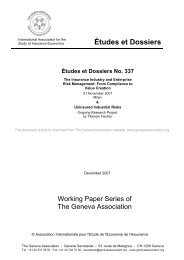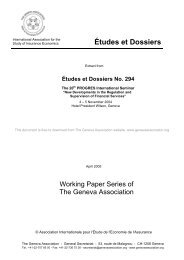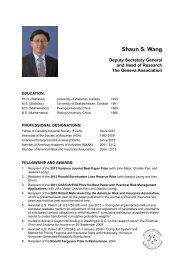Addressing the Challenge of Global Ageing?Funding Issues and
Addressing the Challenge of Global Ageing?Funding Issues and
Addressing the Challenge of Global Ageing?Funding Issues and
You also want an ePaper? Increase the reach of your titles
YUMPU automatically turns print PDFs into web optimized ePapers that Google loves.
8<br />
<strong>Addressing</strong> <strong>the</strong> <strong>Challenge</strong> <strong>of</strong> <strong>Global</strong> <strong>Ageing</strong>—<strong>Funding</strong> <strong>Issues</strong> <strong>and</strong> Insurance Solutions<br />
for <strong>the</strong> lack <strong>of</strong> LTC insurance purchasing is that individuals are inadequately informed<br />
about <strong>the</strong> products available <strong>and</strong> that <strong>the</strong>y ignore low-frequency, high-severity events<br />
that have not occurred recently. Ano<strong>the</strong>r explanation for <strong>the</strong> limited development <strong>of</strong> LTC<br />
insurance markets includes <strong>the</strong> phenomenon <strong>of</strong> adverse selection, i.e. <strong>the</strong> fact <strong>the</strong>re is an<br />
over-representation <strong>of</strong> high risks in <strong>the</strong> insured population.<br />
To address <strong>the</strong> relatively low development <strong>of</strong> <strong>the</strong> market for LTC insurance, Courbage<br />
discusses a number <strong>of</strong> proposals such as combining LTC insurance <strong>and</strong> life insurance,<br />
reverse mortgages or private savings. “The insurance mechanism seems well adapted to<br />
apply to this risk,” Courbage suggests.<br />
Greg Becker, Product Development Actuary at Reinsurance Group <strong>of</strong> America (RGA),<br />
<strong>of</strong>fers an in-depth analysis <strong>of</strong> <strong>the</strong> opportunities <strong>and</strong> limitations associated with <strong>the</strong><br />
insurance industry’s role in addressing longevity funding issues, with an emphasis on<br />
<strong>the</strong> U.K. Becker argues that <strong>the</strong> need for longevity protection has risen as retirement<br />
ages in public <strong>and</strong> private pension arrangements have not kept pace with increased life<br />
expectancy. While <strong>the</strong>re is no doubt that <strong>the</strong> need for longevity derisking solutions is<br />
large, estimates vary, according to Becker. He presents a recent estimate <strong>of</strong> pension<br />
assets which provides a guide to <strong>the</strong> size <strong>of</strong> <strong>the</strong> longevity market: <strong>the</strong>re was more than<br />
US$27.5tn invested in pension fund assets at <strong>the</strong> end <strong>of</strong> 2011.<br />
An individual’s projected retirement income can be seen as a proxy for an individual’s<br />
longevity risk, as captured by <strong>the</strong> pension replacement ratio (PPR). The difference<br />
between countries is enormous, with <strong>the</strong> PPR ranging from slightly more than 40 per<br />
cent in Australia to about 90 per cent <strong>of</strong> <strong>the</strong> final salary in Italy. Equally different are<br />
<strong>the</strong> specific contributions by <strong>the</strong> three main pillars <strong>of</strong> <strong>the</strong> retirement system. Becker<br />
elaborates on <strong>the</strong> reasons for this heterogenous picture <strong>and</strong> provides a concise overview<br />
<strong>of</strong> <strong>the</strong> various insurance products that have been designed to mitigate longevity risk, both<br />
from an employer’s <strong>and</strong> an individual’s point <strong>of</strong> view. He believes that reinsurers have a<br />
particular competitive edge in providing such solutions due to <strong>the</strong>ir global perspective,<br />
<strong>the</strong>ir superior diversification <strong>and</strong> <strong>the</strong>ir existing liability portfolio which <strong>of</strong>fers a certain<br />
degree <strong>of</strong> mortality risk as a natural <strong>of</strong>fset. “Thanks to <strong>the</strong>ir multi-national exposure, <strong>and</strong><br />
since different countries <strong>and</strong> markets are exposed to different mortality <strong>and</strong> longevity<br />
drivers—whe<strong>the</strong>r <strong>the</strong>y be social, economic or catastrophic in nature—increasing one’s<br />
geographic diversity lowers <strong>the</strong> volatility <strong>of</strong> <strong>the</strong> portfolio in aggregate,” <strong>the</strong> author points<br />
out.<br />
However, Becker stresses that “(…) <strong>the</strong> need for solutions exceeds capacity, <strong>and</strong> some nontraditional<br />
<strong>and</strong> alternative approaches need to be considered.” He specifically elaborates<br />
on capital market-based solutions such as a traded longevity index as pioneered by <strong>the</strong><br />
The Life <strong>and</strong> Longevity Markets Association, a U.K.-based body. Investors (like hedge<br />
funds) might be enticed by <strong>the</strong> additional diversification <strong>of</strong>fered by this new asset class.<br />
Krzyszt<strong>of</strong> M. Ostaszewski explains in his second contribution why all four pillars <strong>of</strong> oldage<br />
protection need to work in concert to enable a holistic <strong>and</strong> sustainable set <strong>of</strong> solutions.<br />
The author focuses on <strong>the</strong> four pillars as a key component <strong>of</strong> modern economies’ financial<br />
infrastructure <strong>and</strong> <strong>the</strong> need to ensure positive “real economy” implications—in light <strong>of</strong><br />
<strong>the</strong> lessons from <strong>the</strong> recent financial crisis, which saw large parts <strong>of</strong> <strong>the</strong> financial system<br />
develop into a major liability <strong>and</strong> drag on real economies.<br />
Referring to <strong>the</strong> design <strong>of</strong> public <strong>and</strong> private retirement systems, Ostaszewski proposes<br />
that “<strong>the</strong> problems <strong>of</strong> Greece in early 2012 are not unlike <strong>the</strong> problems that even <strong>the</strong>








